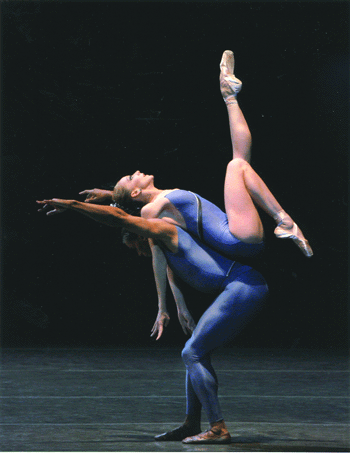Elo’s sharply honed Diamond Project Dance
If anyone could dance Jorma Elo’s Diamond Project commission it would be the formidable dancers of the New York City Ballet—renown everywhere for their speed. The Finnish choreographer made the acclaimed “Plan to B” for Boston Ballet where he is now in residence.
On Friday, June 16, Elo’s “Slice to Sharp,” set on eight City Ballet dancers, premiered at the New York State Theater. Saturday afternoon it was first on the program. The dancers sometimes skittered to keep in step. But Saturday’s slips were clearly dips, glides, and short stops on Tuesday evening. “Slice’s” every phrase proved interesting and necessary, every movement defined and, indeed, sharp.
David Briskin conducted The New York City Ballet Orchestra and violin soloists Kurt Nikkanen and Michael Roth in the Third Movement of a Partia by the 17th century composer Heinrich Ignaz Franz von Biber and a medley of movements from eight concertos by Antonio Vivaldi.
It begins like a center warm-up gone awry—arms out to the side slice the air—setting the ballet in motion. In dim light their canonical or unison combinations give no false sense of community. Then a series of duets, trios, solos highlight lovely lifts of Ana Sophia Scheller, Maria Kowroski’s strength, Joaquin De Luz’s pleasing partnering and his restraint in virtuoso pirouettes, or half-turns of Sofiane Sylvie, quick twists of her upper body, her fluid arms and Egyptian angularity in duet with Amar Ramasar.
Edwaard Liang conveys emotive power and even humor with his rippling torso or tiny flicks of his wrist or neck, or with gesturers that seem to direct his journey. Seeming to live in the music as if he were improvising, his solo embodies the violinist’s complex arpeggios and double-stops.
Wendy Whelan and Craig Hall negotiate power in questioning gestures, an entrapping arabesque, or with arms framing faces. The weight of her hand on his head can be felt through the house. In this beautifully understated duet/relationship vignette, form meets psychology.
Elo’s endings are unexpected. Scheller’s final exit is dramatic if unceremonious. She’s lifted out into the wings to the final push of “La Tempesta di Mare” First Movement, Presto. It’s been said that endings are forty percent of the dance—this is one that couldn’t be argued with.
Twenty performed Peter Martins’ winter season premiere “Friandises,” led by Tiler Peck and Daniel Ulbricht. Though it’s timed like clockwork, there is nothing regimented about this lyric and airy ballet to Christopher Rouse’s dansant new music. As Tuesday’s curtain raiser, it brought the audience to attention.
Martins’ ballet is crisp and clean with intriguing simplicity of form and cohesiveness. The dancers rule in uniform gray leotards with different colored trim for each pair. A suite of French dances each with a different feeling or meter was Rouse’s inspiration for “Friandises,” and this is the source of Martins’ concrete structure. The ballet is more than the sum of its parts, moving us without further obvious layers or ‘depth.’ In Saturday’s “Intrada” Peck drops into splits to the ring of cymbals. Six dance a sarabande of lifts in V shapes to beautiful violins. Aside from Peck’s awesome pirouettes and Ulbricht’s buoyant tours en l’air, Adrian Danchig-Waring was noticed in the final triumphant galop. Andrea Quinn conducted the New York City Ballet Orchestra’s elucidating performance.
Capping the evening is Balanchine’s “Vienna Waltzes” to Johann Straus, Franz Lehar, and Richard Straus. The rich choreography includes satiny costumes by Karinska and elaborate sets by Rouben Ter-Arutunian. It begins in a Vienna Wood, morphs into a frilly romp in which De Luz impressively partners Miranda Weese. Character cum virtuoso Tom Gold inevitably appears in the funny polka. The trees are raised miraculously and their roots twine and vine around a lavish art nouveau hall. The dance styles and costumes progress from court to ballroom and the eye candy seduces us into this affirmation of tradition. Indeed, this eclectic program honors the relatively short history of ballet.
gaycitynews.com


































